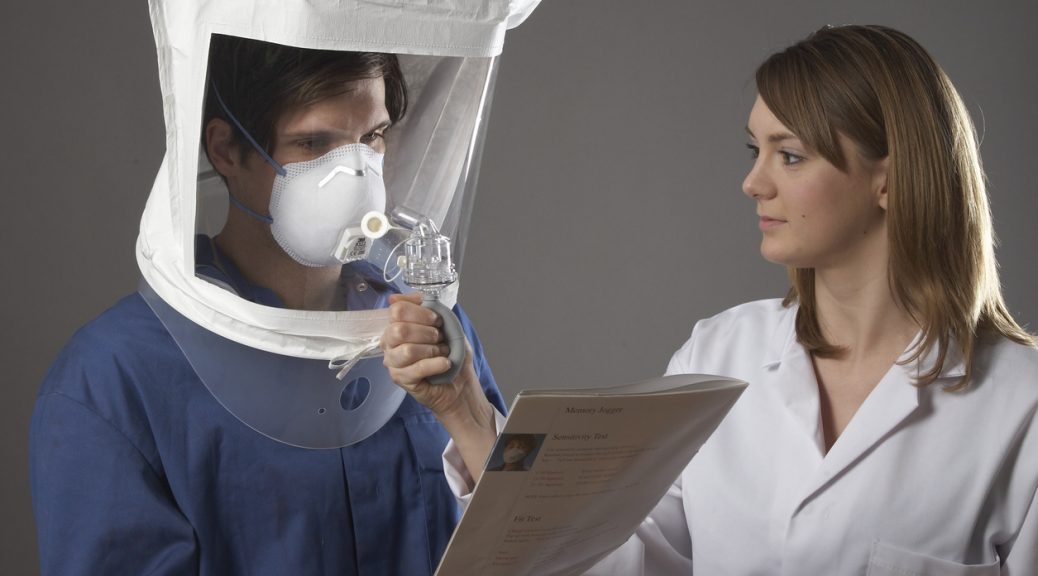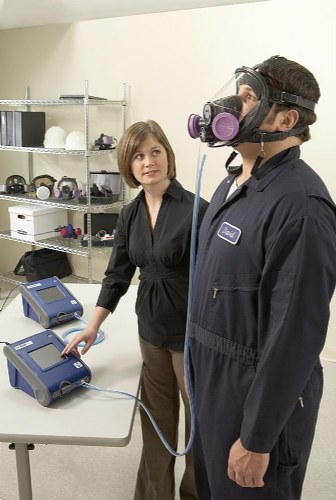Tight-fitting respirator’s evaluation should include its fitting performance against wearer’s facial surface as well as its filtration performance, since any leak path along the respirator/face interface can cause direct exposure to the infiltrated airborne particles. Therefore, fit testing is required in the US by the Occupational Safety and Health Administration (OSHA) (1) before a user wears a mandatory respirator on the job, and (2) must be assessed at least annually. In addition, fit tests also should be performed (3) whenever a different size, style, model or make of respirator is used and (4) when any facial changes occur that could affect fit, such as significant weight fluctuation, major dental work or major facial injury.
The respirator fitting test is a test protocol conducted to verify that a respirator is both comfortable and correctly fits the user. There are two main methods of fit testing available:, either qualitatively detected by the wearer’s sense of taste, smell, or involuntary cough (irritant smoke) or quantitatively measured by an instrument, to verify the respirator’s fit.
The fit test protocol should follow the OSHA procedure (OSHA 29CFR1910.134) as below and each test exercise shall be performed for one minute except for the grimace exercise which shall be performed for 15 seconds. The detail information can be found in OSHA website below.
(https://www.osha.gov/laws-regs/regulations/standardnumber/1910/1910.134AppA)
(1) Normal breathing. In a normal standing position, without talking, the subject shall breathe normally.
(2) Deep breathing. In a normal standing position, the subject shall breathe slowly and deeply, taking caution so as not to hyperventilate.
(3) Turning head side to side. Standing in place, the subject shall slowly turn his/her head from side to side between the extreme positions on each side. The head shall be held at each extreme momentarily so the subject can inhale at each side.
(4) Moving head up and down. Standing in place, the subject shall slowly move his/her head up and down. The subject shall be instructed to inhale in the up position (i.e., when looking toward the ceiling).
(5) Talking. The subject shall talk out loud slowly and loud enough so as to be heard clearly by the test conductor. The subject can read from a prepared text such as the Rainbow Passage, count backward from 100, or recite a memorized poem or song.
(6) Grimace. The test subject shall grimace by smiling or frowning. (This applies only to QNFT testing; it is not performed for QLFT)
(7) Bending over. The test subject shall bend at the waist as if he/she were to touch his/her toes. Jogging in place shall be substituted for this exercise in those test environments such as shroud type QNFT or QLFT units that do not permit bending over at the waist.
(8) Normal breathing. Same as exercise (1).
1. Qualitative fit testing (QLFT)
Qualitative fit tests (QLFT) provide pass/fail results and rely on the wearer’s senses using one of four OSHA-accepted test agents: (1) Isoamyl acetate (banana smell) for testing respirators with organic vapor cartridges, (2) Saccharin solution aerosol (sweet taste) for respirators with a particulate filter of any class, (3) Bitrex® solution aerosol (Denatonium Benzoate, bitter taste) for respirators with particulate filters of any class, or (4) Irritant smoke (stannic chloride) for testing respirators with level 100 particulate filters. They provide a subjective measure of the quality of the seal of the facepiece to the wearer’s face. Generally, they are inexpensive, easy to perform and require no specialized equipment or highly trained test operators, but the results strongly rely on wearer’s response and are unable to test full face masks.
2. Quantitative fit testing (QNFT)
Quantitative fit tests give an objective measure of the quality of the seal between the wearer’s face and the facepiece. These tests are much more complicated to perform than qualitative tests and require specialized equipment. There are three OSHA-accepted QNFT test protocols: (1) Generated aerosol uses a non-hazardous aerosol such as corn oil generated in a test chamber, (2) Condensation nuclei counter (CNC) uses ambient aerosol and doesn’t require a test chamber, and (3) Controlled negative pressure (CNP) uses a test that creates a vacuum by temporarily cutting off air.
From the QNFT, a “Fit Factor” number is calculated based on the particle concentration comparison between inside and outside of the test respirator and a fit factor of at least 100 is required for half-mask respirators and a minimum fit factor of 500 for a full facepiece negative-pressure respirator. These QNFTs can provide objective numerical results, where wearers cannot influence the result, but These tests are much more complicated to perform than QLFTs and require specialized equipment.
References (Fit Testing)
- Rengasamy S, Shaffer R, Williams B, Smit S. A comparison of facemask and respirator filtration test methods. J Occup Environ Hyg. 2017;14(2):92-103. doi:10.1080/15459624.2016.1225157
- FDA: “Guidance for Industry and FDA Staff. Surgical Masks - Premarket Notification [510(K)] Submissions; Guidance for Industry and FDA.” https://www.fda.gov/regulatory-information/search-fda-guidance-documents/surgical-masks-premarket-notification-510k-submissions
- ASTM: ASTMF2299-03, Standard Test Method for Deter- mining the Initial Efficiency of Materials Used in Medical Face Masks to Penetration by Particulates Using Latex Spheres. West Conshohocken, PA:ASTM International, 2003.
- ASTM: F2101- 01: Standard test method for evaluating the bacterial filtration efficiency (BFE) of medical face mask materials, using a biological aerosol of Staphylococcus aereus. Ann. ASTM Stand. (F2101-01): 1553–1557 (2001).
- ASTM: F2100: Standard specification for performance of materials used in medical face masks. Ann. Book ASTM Standards, Philadelphia, PA, 2011. pp. 447–449.
- ASTM:“ASTM F1215 - 89. Test Method for Determining the Initial Efficiency of a Flatsheet Filter Medium in an Air- flow Using Latex Spheres (Withdrawn 1998).” Philadelphia, PA: ASTM International, 2003. (1989).
- 3M: “Quantitative Fit Testing of Respirators”, https://multimedia.3m.com/mws/media/1282559O/quantitative-fit-testing-of-respirators-technical-bulletin.pdf
- OSHA: “1910.134 App A - Fit Testing Procedures (Mandatory)”, https://www.osha.gov/laws-regs/regulations/standardnumber/1910/1910.134AppA
- NIOSH: “Healthcare Respiratory Protection Resources: Fit Testing”, https://www.cdc.gov/niosh/npptl/hospresptoolkit/fittesting.html
- 3M: “3M Respirator Fit Kit Test Video”, https://www.youtube.com/watch?v=Syj_zeNtLGI
- TSI: “PortaCount Respirator Fit Tester running OSHA’s Modified CNC Protocols”, https://www.youtube.com/watch?v=l0uDzmEiHYo

